Warning! The brake pads must be replaced on both front/rear brakes at the same time. Remember that the dust generated during the operation of the brake mechanisms may contain asbestos, which is extremely harmful to human health. Never blow off dust with compressed air or inhale it - wear a protective mask or respirator when servicing mechanisms. Never use gasoline or petroleum-based solvents to clean brake system components - use only branded cleaners or methyl alcohol!
Note. The procedure applies equally to both front and rear disc brakes.
1. Remove the cap from the brake fluid reservoir.
2. Loosen the front wheel nuts. Jack up the front/rear of the vehicle and place it on jack stands.
3. Remove front/rear wheels.
Note. All four brake pads on both wheels of the same axle must be replaced at the same time. To avoid confusion, work with each mechanism individually.
4. Carefully inspect the brake disc (see Check of a condition, removal and installation of a brake disk). If it is necessary to perform a groove, remove the disk.
Front wheel brakes
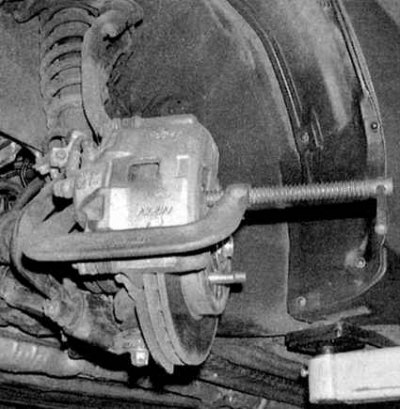
1. Using a clamp, press the piston into the caliper cylinder, thereby providing the necessary free space for installing new pads that are thicker (see accompanying illustration). When the piston is sunk into the caliper, the liquid level in the GTZ reservoir will rise - make sure that it does not start to overflow, pump out the excess if necessary.

2a. Before dismantling the components, be sure to wash them with a special cleaner (see accompanying illustration).
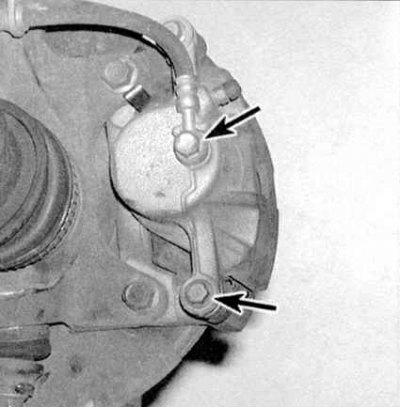
2b. Remove the lower caliper bolt (bottom arrow); the upper arrow shows the hollow bolt of the nipple connection of the brake hose; the hose must be disconnected only if it is necessary to remove the caliper from the vehicle.

2s. Rotate the caliper up to provide access to the brake pads.

2d. To fix the caliper in the raised position, tie it with a wire to the suspension strut.

2e. Remove the outer brake shoe with shim.

2f. Remove the inner brake pad (on some models, the inner shoe is not equipped with an adjusting shim).
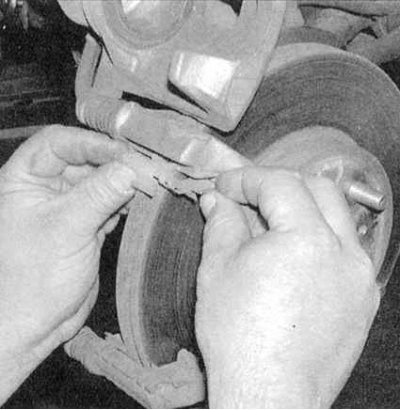
2g. Remove the upper and lower spring shoe holders and check their condition (remember that the inner shoe is also equipped with holders).

2h. Make sure that the spring holders fit securely in their grooves in the caliper anchor bracket (replace holders if necessary).
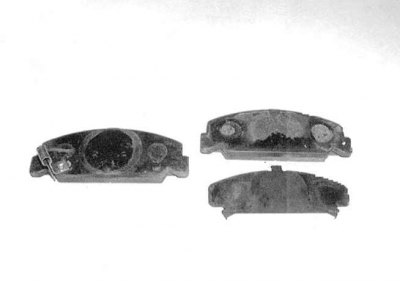
2i. Internal (left) and outer brake pads with outer pad adjusting shim (on some Integra models of recent years of production, the inner shoe is also supplied with an adjusting shim).
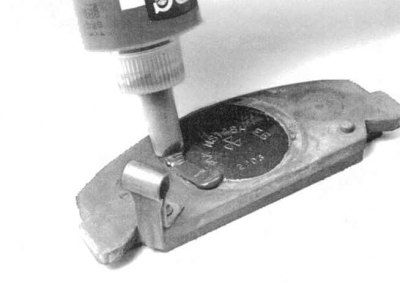
2j. Before installing the shims, lubricate the back side of the pads with a special anti-squeal compound.

2k. Install the inner brake pad (make sure that the tongues on the upper and lower ends of the shoe fit into the reciprocal grooves and are securely fixed with spring holders).

2l. Install the outer brake pad (if the adjusting shim is not included in the set of new pads, install the old shim on the pad).

2m. Before lowering the caliper, do not forget to check the condition of the protective covers of the guide pins; Replace damaged covers.

2n. Before installation, the outer finger of the caliper should be cleaned and lubricated with refractory grease; the same should be done with the lower caliper mounting bolt
Note. This requirement only applies to Civic models with long shoulder bolts and fixed top pins [caliper type 2056]).

2o. Lower the caliper to its original position (if the piston rests against the inner shoe, press it inside the cylinder with a clamp).

2r. Screw in the bottom bolt of a support and tighten it with the demanded effort.
Rear wheel brakes

1a. Turn out fixing bolts and remove a protective screen of a support.

1b. Remove the two caliper mounting bolts.

1s. Remove the caliper from the anchor bracket and tie it with a wire to the suspension element - try not to allow the brake hose to be pulled.

1d. Remove the outer shoe with shim.

1e. Remove the inner shoe with shim.

1f. Remove the pad holders from the caliper (lower holder shown, upper one looks and installed similarly).

2. Coat the backside of the new pads with a special anti-squeal compound (see accompanying illustration). Instructions for using the product are usually printed on the wall of the can.
3. Install your shims on the pads.
4. Install the shoe holders into the caliper anchor bracket. Lubricate the shoe holders with a thin layer of silicone grease.
5. Install new brake pads with shims in the caliper anchor bracket.

6. Using needle-nosed pliers, rotate the piston, sinking it into the caliper cylinder in order to provide the necessary free space for installing new brake pads (see accompanying illustration). First, sink the piston to the bottom of the cylinder, turn it back so that when installing the inner pad, its tide hits one of the selections on the end surface of the piston. Make sure that the anther is not deformed as a result of the rotation of the piston.
7. When you have finished assembling the brake mechanism, reinstall its protective screen.
Brakes front and rear wheels
1. Replace the wheels, lower the vehicle to the ground and tighten the wheel nuts to the required torque (see Specifications to the head Current service).
2. Depress the brake pedal several times and (when changing rear pads) parking brake lever to shrink the pads on the disc.
3. Check the brake fluid level, correct if necessary (see chapter Current service). Before starting the normal operation of the vehicle, make sure that the braking system is working properly.
